Common menu bar links
Breadcrumb Trail
ARCHIVED - Social Sciences and Humanities Research Council - Report
 This page has been archived.
This page has been archived.
Archived Content
Information identified as archived on the Web is for reference, research or recordkeeping purposes. It has not been altered or updated after the date of archiving. Web pages that are archived on the Web are not subject to the Government of Canada Web Standards. As per the Communications Policy of the Government of Canada, you can request alternate formats on the "Contact Us" page.
SECTION II: ANALYSIS OF PROGRAM ACTIVITIES BY STRATEGIC OUTCOME
Strategic Outcome 1.0: People—A First-Class Research Capacity in the Social Sciences and Humanities
One of the key outcomes of SSHRC’s programs is developing talented people. This talent comes in the form of research trainees, new researchers embarking on promising careers, and established researchers with international reputations. SSHRC’s program activities directly supporting the development of talent are described below. SSHRC also supports talent development indirectly, by funding research projects that engage students at all levels in conducting research.
The federal government’s S&T strategy recognizes that talented, skilled, creative people are the most critical element of a successful national economy. Demand is growing rapidly for highly qualified personnel who are creative, analytical and articulate, as well as sophisticated in their understanding of individuals, communities and societies in the past and present. This is what SSHRC’s investments in people help to produce. Canada is striving to become a magnet for the highly skilled people we need to thrive in the modern global economy. Having the best-educated, most highly skilled and flexible workforce in the world will generate Canada’s People Advantage.
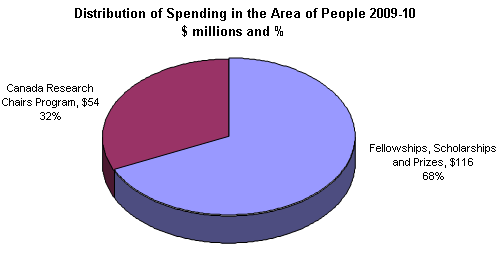
In 2009-10, SSHRC awarded fellowships and scholarships to 1,483 full-time master’s students and 1,141 doctoral candidates to receive research training in a variety of social sciences and humanities disciplines, and gain skills and experience that will help them build successful careers in all sectors of society. Further, 131 of these graduate students also received Canada Graduate Scholarships Michael Smith Foreign Study Supplements to pursue research study opportunities outside Canada, thereby gaining valuable international experience and strengthening collaboration between Canadian and foreign universities.
SSHRC also administers the Canada Research Chairs Program on behalf of SSHRC, NSERC and CIHR. The program is designed to create 2,000 high-profile research professorships for established and up-and-coming researchers at Canadian universities. Attracting internationally renowned scholars, the program helps keep research jobs and expertise in Canada, and increases national research capacity in the social sciences and humanities, engineering, health sciences, and the natural sciences. During 2009-10, SSHRC’s president served as chair of the program’s steering committee.
Program Activity 1.1: Fellowships, Scholarships and Prizes
SSHRC offers several award programs for advanced study and research in the social sciences and humanities at the master’s, doctoral and postdoctoral levels. These programs help train Canada’s researchers and the leaders of tomorrow. In addition, SSHRC offers special fellowships to experienced researchers and supplementary awards to outstanding doctoral and postdoctoral fellowships recipients. Finally, two commemorative prizes recognize the extraordinary dedication and creativity of Canada’s best researchers.
| 2009-10 Financial Resources ($ millions) | 2009-10 Human Resources (FTEs) | ||||
|---|---|---|---|---|---|
| Planned Spending | Total Authorities | Actual Spending | Planned | Actual | Difference |
| 109.8 | 116.8 | 117.4 | 17 | 20 | +3 |
*The major difference between planned and actual spending is due to the $7 million received for the CGS program as part of Canada’s Economic Action Plan.
| Expected Results | Performance Status | Performance Summary |
|---|---|---|
| Highly qualified personnel, expert in research, are available to pursue knowledge-intensive careers within universities, industry, government and other sectors. | Met expectations |
|
Distribution of Spending in the Area of Fellowships, Scholarships and Prizes, 2009-10 $ millions and %
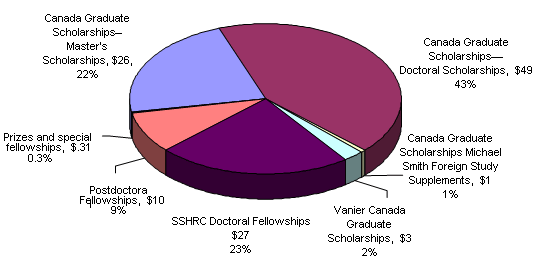
| Overall Trend: No change in applications and awards |
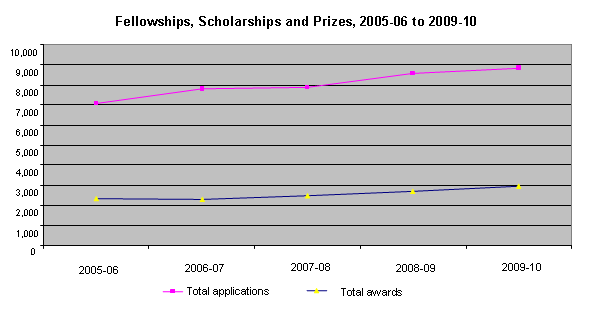
Canada’s Economic Action Plan
Budget 2009 provided $17.5 million over three years to the CGS program for SSHRC to fund 500 additional doctoral and master’s scholarships beginning in 2009-10.
These funds provided an additional 100 doctoral scholarships, valued at $35,000 each year for three years beginning in 2009-10, and an additional 200 master’s scholarships, valued at $17,500 each for
one year.
| Doctoral | Master’s | Actual Spending | |||
|---|---|---|---|---|---|
| Year | Increased number of scholarships | Value of each (per year) | Increased number of scholarships | Value of each (per year) | |
| 2009-10 | 100 new | $35,000 | 200 new | $17,500 | $6.8 million |
This initiative will help to train highly skilled graduate students and postdoctoral researchers on issues related to business. These individuals will go on to work in all sectors of the economy, bringing with them new knowledge and understanding of business issues.
Benefits for Canadians
Scholarships to master’s and doctoral students, and fellowships to postdoctoral researchers launching a research career directly support the development of outstanding new research talent for Canada. People with graduate degrees in the social sciences and the humanities have research skills that serve them and Canada well, whether graduates go on to work within academia or in other sectors of the economy. Doctorate holders who have support at the launch of their research careers are better able to undertake new research, publish, develop personal research networks, and prepare to become competitive in national research competitions. This directly contributes to developing first-class Canadian research capacity in the social sciences and humanities.
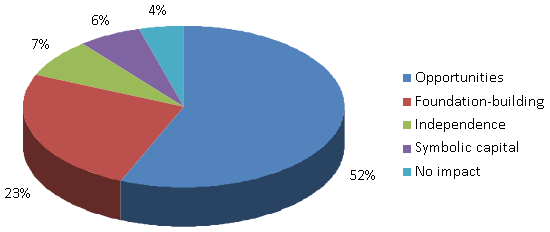
Perceived impact of SSHRC funding
| The majority of former SSHRC scholarship/fellowship award holders who responded to the Graduates Career Survey reported that their SSHRC funding had a positive impact on their career paths. Perceived impacts ranged from new opportunities enabled (e.g., better résumé, networking, publishing) to enhanced independence (e.g., financial freedom, ability to focus on research/studies) and symbolic capital (e.g., academic recognition, improved reputation). Most respondents also reported that SSHRC funding had an influence on their decision to undertake graduate studies or postdoctoral research. |
Performance analysis
SSHRC’s fellowships, scholarships and prizes help address the demand for people with high levels of postsecondary education in all sectors of the economy. In 2009-10, SSHRC awarded a total of 2,972 fellowships and scholarships to talented people. These people will ultimately pursue careers in all sectors of the economy, contributing to Canada’s knowledge-based, innovative society.
The Graduates Career Survey pilot projectreport presents the findings from a survey with 643 former SSHRC-funded master’s and doctoral students and postdoctoral researchers on career pathways, international mobility and perceptions of SSHRC funding. The findings indicated that a large majority (more than 90 per cent) of respondents are currently employed. Of the employed respondents who had received doctoral or postdoctoral funding, most are employed full-time in the academic sector, while the majority of employed CGS master’s graduates are working for either the public service or the private sector (see figure below).
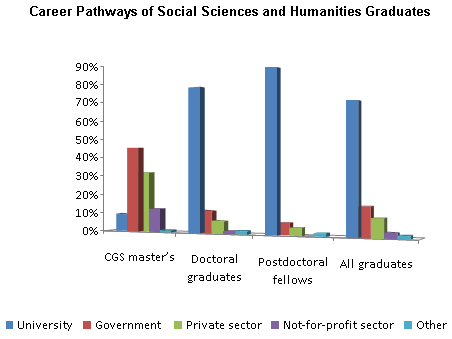
New opportunities, foundation-building (e.g., skills/knowledge gained, career basis established) and independence were cited most frequently by respondents as the main impacts SSHRC funding had on their career pathways. Among doctoral graduates, international experience was identified as the most important opportunity, followed by integration into academia, while those who had received funding for postdoctoral research believed their award allowed broader, more diversified career opportunities.
In order to meet the objectives of the Vanier CGS program, the three federal research granting agencies committed to achieving program harmonization in year two of the program’s implementation. Best practice activities undertaken to achieve full harmonization included developing a common website, similar agency program descriptions, harmonized program delivery and platforms, and interim co-ordinating functions.
The SSHRC Doctoral Fellowships program review and management response were completed and approved in January 2010. Evidence from the program review suggests the program was associated with the following positive outcomes:
- increased subjective incentives for students to enrol in doctoral studies;
- increased recognition by the research community of the federal government’s financial support for research training; and
- increased high-quality research.
In addition:
- SSHRC Doctoral Fellowship recipients were more likely than non-recipients to state that graduate studies improved their prospects of getting a permanent job in an area relevant to their studies;
- compared to non-recipients, SSHRC Doctoral Fellowship recipients were more likely to feel they had more freedom to study where they wanted; and
- SSHRC Doctoral Fellowship recipients were more likely than non-recipients to be involved in core research activities during their studies.
Rewarding excellence The SSHRC Postdoctoral Prize went to Bruce Maxwell for his collaborative, interdisciplinary work on the psychology behind people’s ethical choices and moral judgment. Erin Soros, a former Fulbright scholar who received her master’s degree from The University of British Columbia, received the $5,000 William E. Taylor Fellowship for her doctoral work combining human rights law, philosophy and autobiography. |
Lessons learned
While the SSHRC Doctoral Fellowships program review pointed to some interesting findings regarding the international component of the program, limited information was available on outcomes. The program review identified a need to develop a logic model and performance measurement strategy for the program in order to ensure that performance information is monitored and collected in a systematic way that feeds into the decision-making process. As such, one of the evaluation recommendations highlighted the need for the development of a comprehensive performance measurement strategy to support subsequent program evaluation. The Departmental Evaluation Committee approved the action plan and, as a result, such a strategy will be developed and implemented by 2011-12.
Program Activity 1.2: Canada Research Chairs
By helping Canadian universities and their affiliated research institutes and hospitals become world-class centres of research and research training, the Canada Research Chairs Program contributes to enhancing Canada's competitiveness in the global, knowledge-based economy, improving Canadians' health and enriching our social and cultural life. Specifically, the program seeks to: strengthen research excellence in Canada and increase Canada's research capacity by attracting and retaining the best researchers; improve the training of highly qualified personnel through research; improve universities' capacity to generate and apply new knowledge; and promote the best possible use of research resources through strategic institutional planning, and through collaboration among institutions and between sectors
| 2009-10 Financial Resources ($ millions) | 2009-10 Human Resources (FTEs) | ||||
|---|---|---|---|---|---|
| Planned Spending | Total Authorities | Actual Spending | Planned | Actual | Difference |
| 61.5 | 61.5 | 55.7 | 15 | 12 | -3 |
| Expected Results | Performance Status | Performance Summary |
|---|---|---|
| World-class research capacity in the social sciences and humanities is enhanced in Canadian universities and research institutes through the attraction and retention of excellent researchers. | Met expectations |
|
| Overall Trend: No change |
Benefits for Canadians
The Canada Research Chairs Program invests $300 million a year in up to 2,000 research professorships within universities across Canada to attract and retain some of the world's most accomplished and promising minds. By helping Canadian universities and their affiliated research institutes and hospitals become world-class centres of research and research training, the program contributes to enhancing Canada's competitiveness in the global, knowledge-based economy, improving Canadians' health, and enriching our social and cultural life. The newly launched Canada Excellence Research Chairs Program reinforces this effort by attracting the very top tier of world-class researchers to Canadian universities and supporting research teams working in identified areas of strategic importance to Canadians.
Performance Analysis
Since the Canada Research Chairs Program reached maturity in 2006-07 (all 2,000 Chair positions allocated to institutions), it was observed that approximately 10 per cent of the chairs are empty at any given time due to regular termination cycles, resignations and the time needed by universities to put forward new nominations. This explains the variance between the program’s planned and actual spending.
The program’s 10th-year summative evaluation is underway, and expected to be completed in 2010-11. The evaluation’s findings and recommendations will inform the renewal of the program’s Terms and Conditions, due to expire in March 2011.
In addition to its ongoing management of the Canada Research Chairs Program, SSHRC was also responsible for implementing the Canada Excellence Research Chairs Program announced in Budget 2008.
Phase 2 of the inaugural Canada Excellence Research Chairs competition was designed and launched in 2009-10, with winners announced in May 2010. As a result of Phase 1, during which universities competed for the opportunity to establish chairs at their institution, 17 universities were invited to submit 40 nominations to Phase 2. Fifteen universities put forward 36 nominees whose research focused on one of the four priority areas outlined in the Government of Canada’s S&T strategy.
Phase 2 took place in the beginning of 2010 and involved four levels of review:
- Four to six subject matter experts per proposal reviewed nominations in isolation.
- A review panel of national and international experts compared the nominations and prepared written reports on the strengths and weaknesses of each nomination.
- A selection board composed of national and international experts, as well as distinguished Canadians, assessed the nominations to determine which ones represented the best strategic investments, and recommended up to 20 potential chairholders.
- A steering committee composed of the presidents of the granting agencies and the Canada Foundation for Innovation (as an observer), and the deputy minister of Industry Canada, reviewed the process to ensure its integrity, and approved the recommendations from the selection board.
Lessons Learned
In November 2009, the Canada Research Chairs Program conducted a review of its peer review processes, policies and deadlines, with the goal of increasing flexibility to institutions and finding efficiencies. As a result, changes were implemented at various levels of the nomination and review process. Some of these changes help institutions better plan their Chair nominations, and therefore optimize their use of the program’s resources.
The Canada Research Chairs Program launched a one-year pilot project to speed up the assessment of the eligibility of emerging researchers with less common training or career backgrounds, and significantly reduce the burden on institutions of preparing a full nomination package.
To ensure the best qualified candidates would be selected for Canada Excellence Research Chairs, an innovative peer review process was carefully designed and implemented for the program. The review process was built on best practices of the three granting agencies and the Canada Research Chairs Program. This process, divided into two phases, guided the selection of the best and most suitable researchers for Canada Excellence Research Chairs.
Strategic Outcome 2.0: Research—New Knowledge Based on Excellent Research in the Social Sciences and Humanities
SSHRC is Canada’s key instrument for supporting world-class research in the social sciences and humanities. The activities under SSHRC’s research strategic outcome help create a broad spectrum of knowledge and capacity in such areas as anthropology, law, social work, urban and regional studies, linguistics, literature, business, economics, education and fine arts. This capacity for creating knowledge and understanding is a critical factor for Canada’s quality of life and competitiveness in the knowledge economy and, as a result, is critical in ensuring Canada’s Knowledge Advantage.
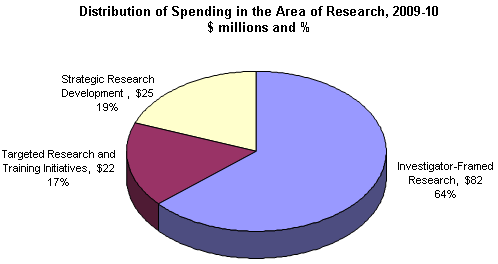
In 2009-10, SSHRC awarded 1,200 research grants to scholars to perform world-class research at postsecondary institutions across the country on a vast array of topics, including digital media, the economy, Arctic sovereignty, climate change and religious diversity.
SSHRC awards its grants through an independent peer review process. Selection committees recommend which projects to fund based on criteria such as the originality and significance of the research, the quality of training offered to students, and the potential impacts of the research within and outside the academic world. A total of 529 committee members participated in SSHRC application adjudications in 2009-10.
Program Activity 2.1: Investigator-Framed Research
SSHRC research grants support individual and team projects and programs of research for which the applicant(s) propose(s) the research topic and methodology. These range from individuals or small groups working in libraries and archives to large, multidisciplinary, collaborative projects with researchers, partners and assistants conducting fieldwork across the country
| 2009–10 Financial Resources ($ millions) | 2009–10 Human Resources (FTEs) | ||||
|---|---|---|---|---|---|
| Planned Spending | Total Authorities | Actual Spending | Planned | Actual | Difference |
| 85.3 | 85.5 | 85.7 | 32 | 35 | +3 |
Actual spending for investigator-framed research was $85.7 million in 2009-10, a slight decrease from the $89.7 million spent in 2008-09. The decrease of approximately $4 million can be attributed in large part to results of a strategic review in 2009.
| Expected Results | Performance Status | Performance Summary |
|---|---|---|
Investigator-framed research creates a synergy contributing to observable knowledge advancement and dissemination of research results throughout the academic community and beyond. Highly talented individuals are available to pursue Canadian careers in the social sciences and humanities. |
Met expectations |
|
| Increasing applications and awards |
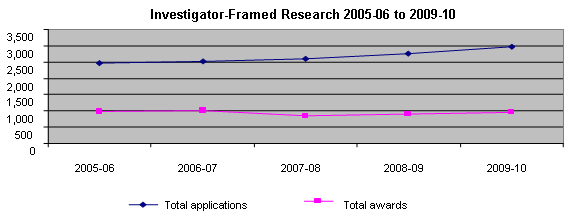
Benefits for Canadians
Through this program activity, SSHRC funds leading-edge research projects undertaken by the very best Canadian social science and humanities researchers. These grants support Canada’s Knowledge Advantage by ensuring Canada has the foundations of knowledge in place in all domains of the social sciences and humanities, and is poised to rapidly respond to demands for knowledge as new issues emerge. This research activity helps develop the foundations of knowledge and explore the social, economic, cultural and intellectual issues that are important to Canada. Because this activity is largely undertaken by researchers based in Canadian postsecondary institutions, it results in a rich and stimulating learning environment for students at all levels and for postdoctoral fellows, contributing to the development of the next generation of highly talented research-trained workers who become leaders across the private, public and not-for-profit sectors.
|
Spatial targeting of conservation programs in agricultural watershed Growing concerns about the adverse environmental effects of agriculture have led to conservation programs both in Canada and United States. These programs typically provide landowners with financial incentives to conserve environmentally sensitive cropland or adopt more environmentally sound production practices. The aim of this SSHRC-supported research was to develop an integrated economic, hydrologic, and GIS modelling system to examine the costs and benefits of conservation measures, and to identify spatial targeting mechanisms. The research results help improve our understanding of tradeoffs of costs and benefits of agricultural conservation programs. The proposed integrated modelling system has been applied to conservation programs in Ontario and Illinois. The research will contribute to better agriculture conservation program management and policy design, and improved cost-effectiveness, in Canada, and in other developed market economies. —Wanhong Yang, Geography, University of Guelph |
Performance Analysis
In 2009-10, both the Standard Research Grants and the Major Collaborative Research Initiatives programs successfully supported excellent research and advanced knowledge in all areas of the social sciences and humanities, allocating 955 new grants overall. Investigator-Framed Research supported more than 2,700 projects in all areas of the social sciences and humanities.
New Standard Research Grants were allocated to 941 projects across Canadian postsecondary institutions for research in more than 30 disciplines and 50 research areas. This represents a 12 per cent increase from the previous year.
The 2009-10 competition for Standard Research Grants—SSHRC’s largest research grant program—received 2,880 applications, requiring 6,201 external assessments. SSHRC awarded 941 Standard Research Grants, for a total investment of more than $75 million over three years. In line with SSHRC’s efforts to encourage the work of emerging researchers, this total included 182 one-year grants to new scholars.
SSHRC has a very strong reputation for funding research excellence in Canada. The evaluation of the Standard Research Grants program demonstrated that SSHRC is considered the most important source of social sciences and humanities funding by nearly all those consulted for the evaluation. The majority of alternatives do not provide investigator-framed research in the social sciences and humanities, and most respondents felt that SSHRC is the most appropriate funding delivery agent. In particular, respondents highlighted SSHRC’s excellence in independent peer review, years of experience in delivery, and national-level review and competitions.
“Getting a SSHRC grant provides a sense that you’ve made it.” —Grantee focus group respondent |
The evaluation also found that, for the most part, Standard Research Grants are meeting the current and future needs of social sciences and humanities researchers. The main area of concern is in meeting the needs of new scholars. Finally, the evaluation’s findings strongly suggest that the research supported leads to knowledge advancement within and beyond academia.
SSHRC’s Major Collaborative Research Initiatives program unites the work of many researchers under single, collaborative projects. The result is productive, integrated working relationships among researchers looking into complex intellectually, economically and culturally significant issues. Four new Major Collaborative Research Initiatives grants were awarded in 2009-10. These projects will bring some 140 Canadian and international researchers and experts together to build knowledge on issues such as the rise and development of the emerging economic superpowers India and China; suburban growth in the 21st century; new ways to organize long-term residential care for seniors; and how religion affects our legal, political and social environment. Each initiative will receive close to $2.5 million over seven years.
Lessons Learned
Based on the recommendations of the Blue Ribbon Panel report and SSHRC’s commitment to continuous improvement, the Standard Research Grants application process has moved to a fully electronic online submission process. The process eliminates the need for signed paper copies, and enables applicants to submit all related forms and curricula vitae as electronic attachments, thereby improving and streamlining the overall application and assessment process. Feedback about the easier, simplified process has been extremely positive from both applicants and assessors. SSHRC will make similar changes to other competitions in the coming year.
Program Activity: Targeted Research and Training Initiatives
SSHRC develops and funds programs to support strategic research programs, both on its own and in partnership with other funding providers (including government, private and community organizations). These programs generate new knowledge on pressing social, economic and cultural issues of particular importance to Canadians. One particular stream of strategic programs supports research that will contribute to a better understanding of the impacts of the knowledge-based economy on Canada's economic, social, political and cultural life, and will help to improve Canadians' ability to influence the future for the common good.
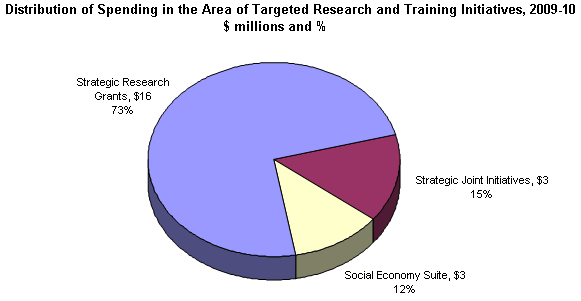
Targeted Research and Training Initiatives awarded 77 new grants in 2009-10. Total grants expenditures were close to $22.4 million. Strategic Research Grants comprise the largest portion (73 per cent) of SSHRC grants investments in targeted research. Strategic research includes funding to priority research areas such as aboriginal research, Canadian environmental issues, the North, and research/creation in the fine arts.
| 2009–10 Financial Resources ($ millions) | 2009–10 Human Resources (FTEs) | ||||
|---|---|---|---|---|---|
| Planned Spending | Total Authorities | Actual Spending | Planned | Actual | Difference |
| 23.1 | 23.8 | 23.8 | 12 | 14 | +2 |
| Expected Results | Performance Status | Performance Summary |
|---|---|---|
Excellent SSHRC-funded research targeted in areas of importance to Canadians (as defined by SSHRC, in consultation with the research community and various stakeholders). Highly talented individuals available to pursue Canadian careers in the social sciences and humanities. |
Met expectations |
|
| Overall Trend: Decreasing applications and awards (Despite important fluctuations, overall trend since 2005-06 has been decreasing applications and Awards.) |
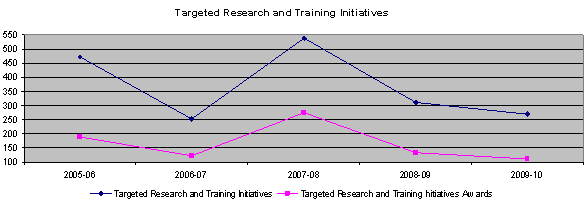
Benefits for Canadians
Targeted Research and Training Initiatives mobilize Canada’s best scholars to undertake research on priority areas of social, economic and cultural importance to Canadians. Much of this research activity also involves training highly qualified personnel and mobilizing research knowledge. Knowledge developed through these programs can strengthen decision-making in the public, private and not-for-profit sectors. Focusing strategically on research in the national interest is a guiding principle of the federal S&T strategy. SSHRC funds such thematic research mainly through:
- Strategic Research Grants, the themes of which are defined by SSHRC in consultation with stakeholders, including government; and
- Strategic Joint Initiatives, through which SSHRC partners with public, private and not-for-profit organizations to co-fund thematic research and research training initiatives.
This program activity is expected to enhance excellent research and the development of highly talented individuals in areas of importance to Canadians. It is well aligned with the federal S&T strategy commitment to harness S&T to meet Canada’s social and economic needs by supporting research priorities and building partnerships.
New technologies and Canadians with disabilities Access to new technology, such as point-of-sale contact and ATM machines, is a challenge for Canada’s disability community. Through SSHRC’s Initiative on the New Economy, research by the University of Manitoba’s Deborah Stienstra and others, including the Council of Canadians with Disabilities, influenced a Supreme Court decision on telecommunications deferral funds, whereby 5 per cent of $650 million was set aside to ensure better access for the 4.4 million Canadians (14.3 per cent of Canada’s population) with disabilities. The research also contributed to partnership arrangements between the Neil Squire Society, Nokia and RIM to develop accessible solutions for people with disabilities. The City of Vancouver showcased improved access to information, retail and public services at the 2010 Olympic Games. |
Performance Analysis
Targeted Research and Training Initiatives successfully supported research in areas of importance to Canadians. The program activity awarded 77 new grants in 2009-10, worth a total of $22.4 million, to conduct excellent targeted research and various training initiatives.
Environment and North strategic themes—In 2009-10, research on Canadian environmental issues and on northern communities received $4.9 million in funding through SSHRC’s Strategic Research Grants.
Research funded under the Canadian Environmental Issues special call contributed to advancing Canadian research knowledge on climate change, green energy, water management, and the environmental impact of new technologies; while Northern Communities research focused on areas identified in Canada’s Northern Strategy, including sovereignty, environmental protection, governance, and social and economic development.
SSHRC initiated a consultation strategy, identifying potential participants as well as expert facilitators and key questions. Issues discussed included the knowledge needs of research users in Canadian communities, government departments, non-governmental organizations and the private sector; what environmental and northern issues are pressing today; and which of these can benefit from research and knowledge mobilization.
Deployment of a full consultation was delayed due to budget constraints; however, SSHRC continued to monitor issues and topical developments from a variety of sources. SSHRC, along with other granting agencies, Indian and Northern Affairs Canada and other departments, also engaged in discussions on the development of the Canadian High Artic Research Station. Further, SSHRC’s Aboriginal Research Pilot Program continued to see high demand, and members of the program’s adjudication committees were consulted on SSHRC’s long-term strategy for advancing research with and by aboriginal people.
International research collaboration—The International Research Initiative on Adaptation to Climate Change—a collaboration between SSHRC, NSERC, CIHR and the International Development Research Centre—awarded close to $360,000 for targeted, leading-edge research on climate change adaptation involving international research teams. Initiative partners funded 12 letter-of-intent-stage projects, with SSHRC awarding $120,000 for four of the letters of intent.
International Joint Venture Project—Negotiations with lead institution Dalhousie University were completed in 2010, leading to the launch of the Ocean Tracking Network to be supported by the International Joint Venture Project. The Project, a collaboration between NSERC, SSHRC and the Canada Foundation for Innovation, totalling $45 million in funding over five years, will support a joint collaborative research venture between the best oceanographers and ocean management researchers and institutions in Canada and around the world. The SSHRC portion, valued at $327,000 over five years, will provide funding for research on the socio-economic and legal aspects of ocean monitoring.
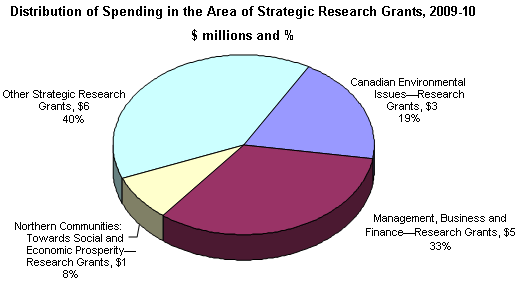
Lessons Learned
To ensure that SSHRC funding for management, business and finance research leads to the greatest benefits for all Canadians, SSHRC completed an in-depth review of Canadian research needs, strengths and weaknesses within these fields in 2009.
This review included: commissioning a report on business research in Canadafromthe Council of Canadian Academies; performing an analysis of SSHRC-funded research grants over the past 10 years; holding consultations with the Canadian Federation of Business School Deans and with SSHRC’s sister granting agencies; and performing outreach activities with the Canadian Federation for the Humanities and Social Sciences, the SSHRC Leaders, the Canadian Council of Chief Executives, the Canadian Labour Congress and other organizations.
Based on evidence gathered, SSHRC decided to focus the management, business and finance research priority on innovation, leadership and prosperity, in order to respond to the complexity, diversity and creativity of the new knowledge paradigm in the 21st century.
SSHRC’s focus on innovation, leadership and prosperity also includes efforts to: increase connections between SSHRC-funded researchers and off-campus communities, increase international collaboration; and build Canada’s capacity in areas such as the digital economy, small- and medium-sized enterprises, public sector management, e-finance, and the manufacturing and service industries.
Program Activity 2.3: Strategic Research Development
Strategic grants, through programs in this program activity, are available to faculty, postsecondary institutions, scholarly associations and not-for-profit organizations to explore, develop and define new perspectives, challenges and priorities in conducting research, disseminating research results, and training new researchers. Strategic research development programs also help develop related research capacity through the promotion of new modes of research collaboration and partnerships.
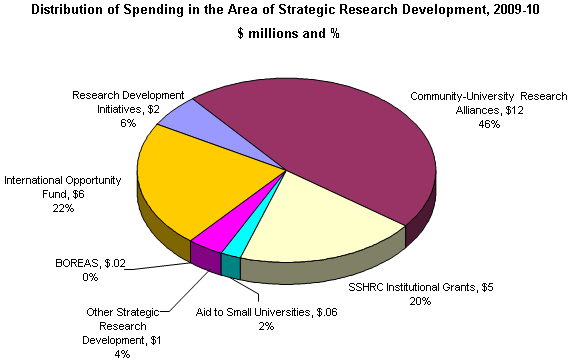
The figure above illustrates the distribution of Strategic Research Development spending by subactivity. SSHRC’s approach to funding partnerships in research and related activities not only increases the social and economic impact of investments in research, but also resonates with commitments in the 2010 Speech from the Throne to facilitate local solutions for tackling local challenges, and to boost the power of innovation at the community level by simplifying access to government support.
| 2008-09 Financial Resources ($ millions) | 2008-09 Human Resources (FTEs) | ||||
|---|---|---|---|---|---|
| Planned Spending | Total Authorities | Actual Spending | Planned | Actual | Difference |
| 26.9 | 26.9 | 25.6 | 7 | 7 | 0 |
| Expected Results | Performance Status | Performance Summary |
|---|---|---|
| Research institutions are supported to conduct research development. New research and new researchers are attracted in strategic and targeted areas. | Mostly met expectations |
|
| Overall Trend: Despite decline from 2008-09, overall trend since 2005-06 has been increased applications and awards |
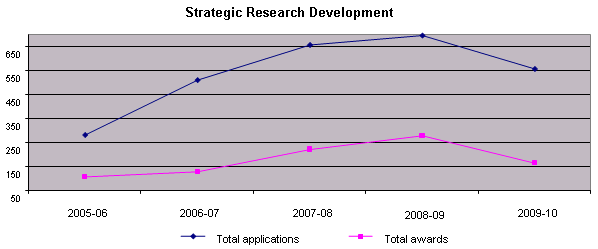
Benefits for Canadians
Through Strategic Research Development, SSHRC funds research activities that explore and develop new perspectives, directions and modes of research. It also enhances institutional capacity for research in the social sciences and humanities, such as through the Research Development Initiatives program, which supports early-stage exploratory research activities in areas emerging beyond established disciplinary, theoretical or methodological boundaries. The Community-University Research Alliances program funds new forms of research partnerships between university-based researchers and community-based organizations, with partners joining forces to define research questions and undertake research on issues of mutual interest. The program ensures that knowledge produced will be applied, as the potential users of new knowledge participate in the research process from the start. The International Opportunities Fund, meanwhile, enables top researchers to collaborate in international research activities, and enhances the leadership role of Canadian scholars in global research efforts. The program supports activities leading to significant international research collaborations and has already become a fund though which international funding agreements are being negotiated.
Connecting beyond campus and beyond borders The Community-University Research Alliances funded by SSHRC support research partnerships between universities and community organizations, including a project at the University of Waterloo to research changes in how people with dementia are supported and cared for. ?Sherry L. Dupuis, Recreation and Leisure Studies, University of Waterloo |
Performance Analysis
Overall, Strategic Research Development received 470 eligible applications and awarded 148 grants. The $25.6 million in actual spending in 2009-10 was 13 per cent lower than in 2008-09. This variation is due to competitions in Innovation, Leadership and Prosperity, Canadian Environmental Issues and Northern Communities, resulting in limited funds available for new awards.
International research collaboration
SSHRC funds research that brings the world to Canada, and Canada to the world. By fostering collaboration among researchers, partners and research funding agencies, SSHRC builds international partnerships on important issues and helps raise Canada’s profile on the global stage.
In 2009, SSHRC announced grants to eight international research projects as part of the Digging into Data Challenge. This partnership—between SSHRC, the United States’ National Endowment for the Humanities and National Science Foundation, and the United Kingdom’s Joint Information Systems Committee—challenged international teams of world-class researchers to push the limits of the digital revolution. Using high-performance computing and digital libraries to mine vast quantities of cultural data (images, texts, musical notations, social statistics and speech, etc.), these interdisciplinary teams will lead substantial innovations into data-mining that will have benefits across the academic, business and public sector worlds.
A partnership between SSHRC and the International Development Research Centre has led to the International Community-University Research Alliances program. The program facilitates collaborations and the creation of new knowledge across sectors and organizations, and between countries. In 2009, the program awarded $8 million in funding, of which SSHRC is contributing $4 million over five years, to four projects teaming community organizations and universities in Canada with counterparts in the developing world to carry out research on global issues, such as the design and delivery of mental health services, coastal environmental change, the impact of poverty on the environment, and services for at-risk youth.
Historical research builds powerful data-mining tools A Digging into Data project to examine 250 years of criminal court proceedings will produce powerful data-mining tools capable of revolutionizing how businesses and governments do public opinion research. The tools will allow users to see how their brands and services appear online, what words are nearby, and whether people have positive or negative things to say about them. ?Geoffrey M. Rockwell, Philosophy, University of Alberta |
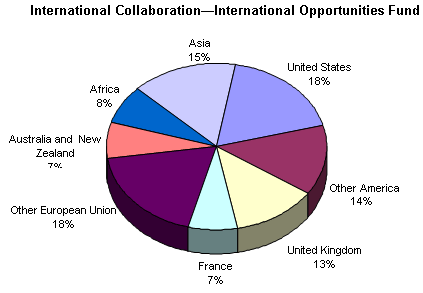
Lessons learned
SSHRC continued to develop a renewed program architecture in 2009-10. It posted a briefing to the community describing the objectives of the architecture renewal, including reducing the number of program offerings, and promoting flexibility within programs of funding. Following on consultation with the social sciences and humanities community, SSHRC recommended to its governing council two funding opportunities in support of formal partnerships to facilitate a broader range of partnerships between the public, private and not-for-profit sectors to harness social sciences and humanities research to address social, economic and management challenges. SSHRC’s program activities are being restructured within three umbrella programs defined by their desired results for Canadians: Talent, Insight and Connection.
Strategic Outcome 3: Knowledge Mobilization—The Transfer, Dissemination and Use of Social Sciences and Humanities Knowledge
Moving new knowledge from academia into areas where it can be applied more directly to the benefit of Canadians has been a dominant theme in SSHRC’s strategic planning for several years. SSHRC understands this challenge in the broadest sense: that it is not merely about “transferring” knowledge after it has been produced, but also about allowing opportunities for practitioners and other research users to participate and influence the knowledge-production process from the beginning. Knowledge mobilization is a key strategy for realizing Canada’s Entrepreneurial Advantage.
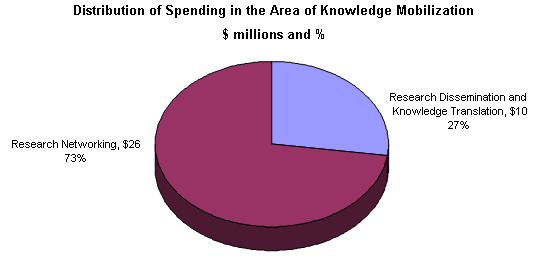
In 2009-10, SSHRC awarded 211 grants through Research Dissemination and Knowledge Translation, and Research Networking—the two program activities under Knowledge Mobilization. Funding through the Knowledge Mobilization strategic outcome represented $35.9 million in 2009-10. Overall, knowledge mobilization funding constituted five per cent of SSHRC grants expenditures in 2009-10.
Lessons learned
In 2009, SSHRC’s new Knowledge Mobilization and Program Integration division held a workshop to discuss the development and implementation of knowledge mobilization strategies. The meeting demonstrated that there is incredible benefit to sharing experiences and lessons learned. As knowledge mobilization is still relatively new, it is important to develop vehicles to systematically collect and share this learning.
Among several recommendations to SSHRC resulting from the workshop was a recommendation to provide support to Knowledge Impact in Society and Strategic Knowledge Clusters program participants to develop a community of practice on knowledge mobilization.
Program Activity 3.1: Research Dissemination and Knowledge Translation
This program activity supports the effective dissemination of social sciences and humanities research results, both within and beyond academia. Through grants to researchers and research institutions, it helps to ensure that research results are accessible to potential users, through both dissemination and engagement activities. Accessibility includes both the availability of research results to a range of audiences through publications (research publishing), as well as the tailoring of research results to the needs of potential users (knowledge translation).
*The variance between planned and actual spending relates to increased spending in grants.
| Expected Results | Performance Status | Performance Summary |
|---|---|---|
| Research results are disseminated effectively both within and beyond academia. | Mostly met expectations |
|
| Overall Trend: Despite fluctuations, overall trend since 2005-06 has been decreasing applications and awards |
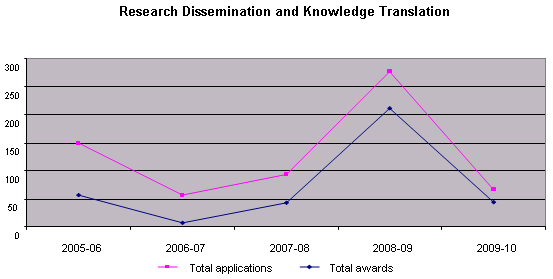
Benefits for Canadians
Through Research Dissemination and Knowledge Translation, SSHRC funds knowledge-sharing activities that are essential for ensuring the dissemination of research results, challenging assumptions, and exploring potential implications for further research. SSHRC also funds knowledge-translation activities through which research results are synthesized and interpreted for specific audiences so that research results can be used in sectors beyond academia. These activities directly maximize the impact of public investments in social sciences and humanities research.
Performance Analysis
The new Research Dissemination and Knowledge Translation program activity features two subactivities—Research Publishing and Knowledge Translation. Through its Public Outreach Grants funding vehicle, Knowledge Translation awarded 28 new grants on a variety of topics, including in SSHRC priority areas.
The restructuring of SSHRC’s program activities has led to irregular patterns in the related trends above, since some of SSHRC’s most well-known scholarly dissemination programs ?Aid to Scholarly Journals and Aid to Research Workshops and Conferences in Canada?were split into separate program activities. Overall, expenditures under Research Dissemination and Knowledge Translation reached close to $10 million in 2009-10.
Program Activity 3.2: Research Networking
This program activity supports interactions between researchers (in academia and other sectors), and between researchers and users of research results (in a range of sectors). These interactions enable researchers, research trainees and others to share and collaborate on research plans and results.
Knowledge impact in society In partnership with 15 Community Futures Development Corporations of Eastern Ontario, the Knowledge Impact in Society project at Queen’s University’s The Monieson Centre has conducted 15 Discovery Workshops to identify local research priorities to support economic development. In fall 2009, the project helped place 96 students in communities across the region to profile local success stories. Over 2009-10, 18 new case studies were produced. The research team also completed 16 knowledge syntheses on workshop-based priorities such as youth retention, community branding, and creating a vibrant downtown. As well, the project organized 10 student consulting projects with local businesses and organizations, and is providing networking opportunities for academics and community leaders through an annual conference and through social media, including the Creative Communities blog, a Twitter site and a Facebook page. —Yolande Chan, The Monieson Centre, Queen’s University |
Research networking is an important part of the research enterprise that is difficult to fund through traditional research grants. Dedicated funding for networking activities acknowledges its important role in fostering high-impact research and innovation. Research networking is supported through grants to researchers and research institutions to fund both discrete events, such as conferences and workshops, as well as more sustained collaborative relationships, such as research networks and clusters.
*The variance between planned and actual spending relates to increased spending in grants.
| Expected Results | Performance Status | Performance Summary |
|---|---|---|
| Researchers interact and work with each other, across disciplines and sectors, and with potential users of research in a range of sectors outside of academia (public, private and not-for-profit). | Mostly met expectations |
|
| Overall Trend: No change in applications and awards |
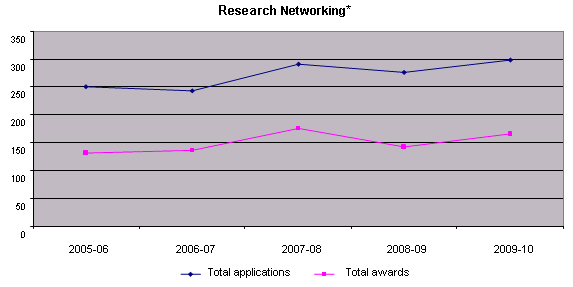
*The numbers of applications and grants from the full suite of Networks of Centres of Excellence programming are not included here due to the networking nature of the programs and irregular competitions.
Benefits for Canadians
SSHRC funds networking activities through which researchers working in different disciplines and/or sectors can collaborate in a sustained way on issues of common interest. Fundamental to these activities is the explicit recognition that Canada’s entrepreneurial challenge is not only a technological one but one that requires better bridges between research and practice, and more people who are skilled in areas such as management, business, marketing and communications, and who have global fluency. The range of networking activities supported by SSHRC are focused on maximizing the impact of public investments in research, and directly foster Canada’s Entrepreneurial Advantage.
Preventing bullying among Canadian children Canada recently ranked ninth-worst among 35 countries for bullying rates among 13-year-olds. The Promoting Relationships and Eliminating Violence Network, a network of Canadian researchers funded through the Networks of Centres of Excellence, is working with public, private and non-governmental organizations to prevent bullying through greater awareness. The network has provided teachers with information on bullying through the Canadian Teachers’ Federation’s national cyber-bullying prevention strategy, and, through Respect in Sport, has trained over 20,000 coaches and youth leaders in anti-bullying approaches. The Network has also run media spots on Canada's Family Channel, and has developed web-based bullying assessment tools for children in grades 4-6 and 7-12. The Network’s methods have so far drawn interest from 75 different countries. See www.nce-rce.gc.ca/NetworksCentres-CentresReseaux/NCE-RCE/PREVNet_eng.asp. |
Performance analysis
Working with members of an intersectoral peer review committee, SSHRC introduced procedural innovations for its Public Outreach Grants competition in 2009-10. The process was structured to invite and effectively compare budgets with no pre-designated upper limit, as well as a mixture of open and thematic proposals—with the latter covering federal investments in environmental and northern issues; and innovation, leadership and prosperity. The result was 44 awards reaching across diverse fields and employing budgets based on flexible identification of optimal knowledge mobilization opportunities.
SSHRC also demonstrated commitment to knowledge mobilization by supporting various forms of research networking (see figure below). SSHRC’s commitments remain constant towards its Research Networking subactivities of Strategic Knowledge Clusters and Research Events, which features two of the most popular SSHRC programs: Aid to Research Workshops and Conferences in Canada, and Aid and Attendance Grants to Scholarly Associations.
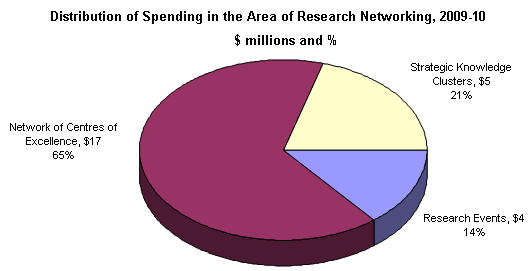
New Networks of Centres of Excellence—Three new Networks of Centres of Excellence were funded as a result of the program’s 2009 competition. Of the three, two involve researchers in non-health social sciences and humanities fields:
- GRAND (Graphics, Animation and New Media) is hosted by The University of British Columbia Centre for Digital Media at the Great Northern Way Campus, with Kellogg Booth as its scientific director. It has 32 projects, a number of which are led by social sciences and humanities researchers, such as Digital Labour: Authors, Institutions and the New Media (www.grand-nce.ca).
- Carbon Management Canada, led by Stephen Larter, is hosted by the University of Calgary and has three main themes. One, Environmental and Human Dimensions, involves approximately 20 social sciences and humanities researchers (www.carbonmanagement.ca).
Knowledge Mobilization Initiative—The 2009 evaluation of the Networks of Centres of Excellence New Initiatives pilot program indicated that ongoing New Initiatives had reached a level of credibility and momentum that would clearly lead to important benefits, and that the initiative added value for multidisciplinary and collaborative research in Canada involving academics and community-based knowledge recipients. In addition, a tri-agency working group, chaired by SSHRC and with a member from Industry Canada, recommended to the Networks of Centres of Excellence Steering Committee that a new Knowledge Mobilization Initiative program be established to build on the successes of the New Initiatives pilot, but with greater emphasis on receptor involvement. The new initiative was approved for launch in July 2010.
Strategic Outcome 4.0: Institutional Environment—A Strong Canadian Science and Research Environment
In Canada, the provincial and federal governments jointly support academic research. The provinces provide the basic physical infrastructure and, supported in part by the Canada Health and Social Transfer, direct and indirect operating costs. The federal government funds the direct costs of research, mainly through the three federal granting agencies—CIHR, NSERC and SSHRC. The term "indirect costs" refers to the central and departmental administrative costs that institutions incur to support research, but are not attributable to specific research projects.
In its 2003 budget, the Government of Canada announced a new program to support the indirect costs associated with the conduct of academic research in institutions that receive research grant funds from any of the three federal granting agencies. This grant program—Indirect Costs Program—recognizes the growing indirect costs of conducting publicly funded academic research. The program was created to help postsecondary institutions maximize the investments in research in one of two ways: 1) secure additional support for the indirect costs of conducting research; or 2) support their mandates to teach and provide community services. By financing a portion of the indirect costs incurred by postsecondary institutions and their affiliated research hospitals and institutes, the federal government both supports world-class research facilities and addresses the needs of smaller Canadian postsecondary institutions. The Indirect Costs Program is administered by the SSHRC-hosted Canada Research Chairs Secretariat, on behalf of the three federal granting agencies.
*Actual Indirect Costs of Research spending was below total authorities by $3.6 million as a result of a Strategic Review in 2008-09.
| Expected Results | Performance Status | Performance Summary |
|---|---|---|
Universities and colleges have the necessary resources, research facilities and services to carry out and mobilize world-class research. Universities and colleges have the ability to meet their institutional teaching and citizenship mandates while carrying out world-class research. |
Met all expectations |
|
| Overall Trend: No change |
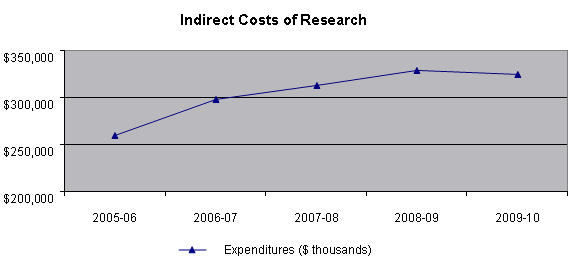
Benefits for Canadians
The Indirect Costs Program supports the institutional environment for research in all fields: the social sciences and humanities, natural sciences and engineering, and health. The program helps fulfill the S&T strategy commitment to “encourage a supportive postsecondary research environment” and contributes to positioning Canada, and Canadian research institutions, as a primary destination for world-class research.
What is the impact of Indirect Costs support? “Funding from sources such as the Indirect Costs Program enriches the University of Alberta’s ability to continue developing leaders and to continue seeking solutions to today’s and tomorrow’s challenges. Research productivity would have been severely hampered by lack of funds for these aforementioned activities, and output would be slowed. Thanks to the Indirect Costs Program support, which helps redirect operating dollars, the University of Alberta is once again leading the way, not only in research but in attraction and retention of world-renowned researchers who work in state-of–the-art facilities.” —University of Alberta |
The key goal of the Indirect Costs Program is to help eligible institutions pay a portion of the indirect costs associated with conducting federally supported academic research. Funding is provided along five key investment areas: facilities, research resources, management and administration, regulatory requirements and accreditation, and intellectual property management.
Indirect costs may include the costs of activities such as gaining library acquisitions, maintaining research databases, renovating laboratories, and promoting research programs to the public. Universities, colleges and other eligible institutions receive Indirect Costs grant allocations based on the average amount of research funding they have received from the three federal research granting agencies over a rolling, three-year period. Smaller institutions, which cannot realize the economies of scale of larger institutions, benefit from a higher allocation formula, which allows them to build their research capacity and excellence.
Performance Analysis
The overall goal of the Indirect Costs Program is to help postsecondary institutions create a research environment that lets them make the best possible use of all federal investments in postsecondary research. In addition to the program’s impacts in its five priority expenditure areas, the program also enhances institutions’ overall ability to conduct research and to recruit and retain researchers. Larger institutions, because they receive larger grants, seem better able to benefit from the program’s positive impacts than do smaller institutions. However, in general, small and mid-sized institutions say that, even though their grants are more modest, these funds play a key role in building their research programs and make a big difference when it comes to their researchers’ work.
On the whole, the institutions that receive Indirect Costs funds invest them mainly in research facilities, management and administration. This distribution remains very similar from year to year, but the proportion of funds spent on regulatory requirements and accreditation does seem to be increasing over time, most likely reflecting an increase in institutions’ and researchers’ responsibilities in these areas. In contrast, the proportion of funds spent on resources seems to be decreasing.
Interestingly, the small and medium-sized institutions spent a large proportion of their Indirect Costs grants on management and administration of their research activities, while large institutions and research-intensive institutions invested almost the same proportion on facilities as they did on management and administration.
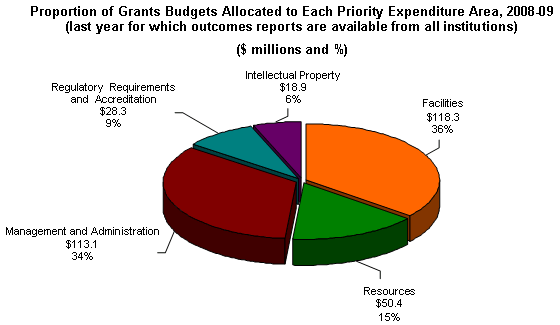
Lessons Learned
As part of the 2009 summative evaluation of the Indirect Costs Program, recommendations were made for strengthening the information base used to assess the program’s impact. As a result, the program’s managers have established a working group of representatives of various organizations, such as postsecondary institutions, the Association of Universities and Colleges of Canada, the Canadian Association of University Business Officers, and the Canadian Association of University Research Administrators. The group has been mandated to define a set of parameters to be used to assess the state of the research environment at Canada’s universities once every five years.
Program Activity 5.1: Internal Services
SSHRC and NSERC share internal services for general administration, human resources, finance, awards administration, and information management and technology services. This common administrative services model has proven highly efficient for the two agencies. In addition, SSHRC has its own corporate services serving the agency’s distinct needs related to board and committee governance, policy, planning, statistics, program evaluation, performance measurement, audit, communications and international affairs.
| 2009-10 Financial Resources ($ millions) | 2009-10 Human Resources (FTEs) | ||||
|---|---|---|---|---|---|
| Planned Spending | Total Authorities | Actual Spending | Planned | Actual | Difference |
| 16.3 | 17.7 | 17.4 | 113 | 128 | +15 |
For further information on SSHRC’s performance related to Internal Services, please see Section I.
